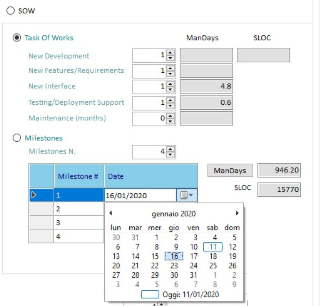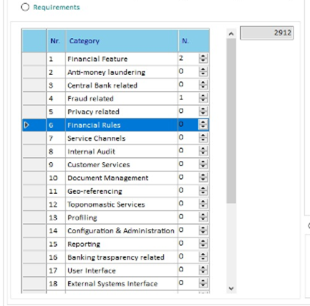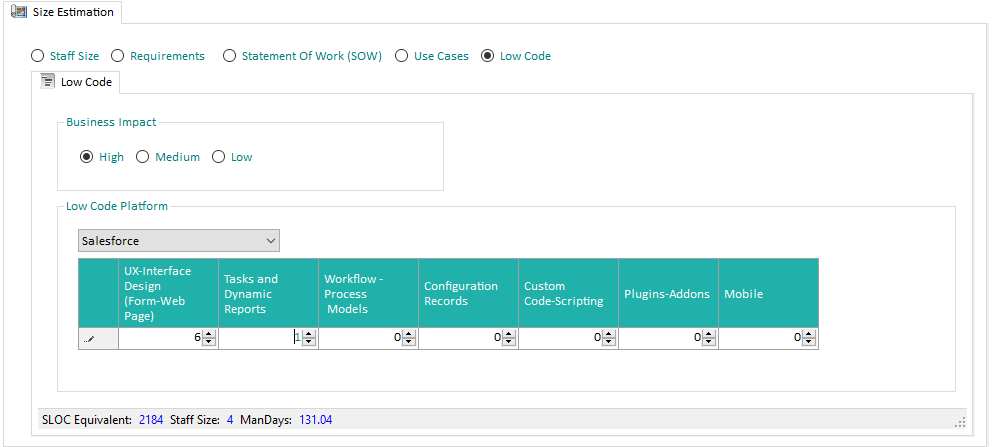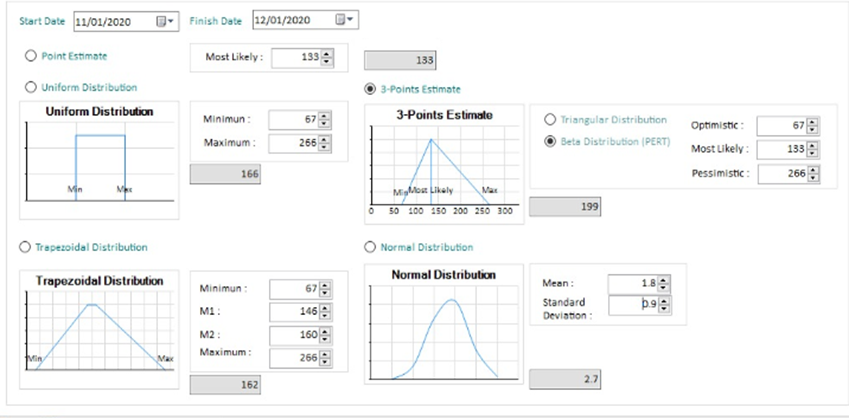| Table of Contents |
|---|
Introduction
...
Quality Reviewer Effort Estimation module measures and estimates the Time, Cost, Complexity, Quality and Maintainability of software project as well as Development Team Productivity by analyzing their source code, the binaries or by accepting a few parameters input. Using a modern software sizing algorithm called Average Programmer Profile Weights (APPW© 2009 by Logical Solutions), a successor to solid ancestor scientific methods as COCOMO, AFCAA REVIC, Albrecht-Gaffney, Bailey-Basili, Doty, Kemerer, Matson-Barret-Meltichamp, Miyazaki-Mori, Putnam, SEER-SEM, Walston-Felix and Function Points (COSMIC FFP, BackFired Function Points and CISQ©/OMG© Automated Function Points) following the ISO 19515:2019 standard. Providing metrics more oriented to Estimation than SEI Maintainability Index, McCabe© Cyclomatic Complexity, and Halstead Complexity. Applying ISO 18484 Six-Sigma methodology developed by Motorola© and Capers Jones© algorithm, Quality Reviewer Effort Estimation produces more accurate results than traditional software sizing tools, while being faster and simpler. By using Quality Reviewer Effort Estimation, a project manager can get insight into a software development within minutes, saving hours of browsing through the code. If Quality Reviewer Effort Estimation is applied starting from early stage development, Project Cost Prediction and Project Scheduling will be a lot more accurate, than using Traditional Cost Models. Our Effort Estimation results have been validated using a number of datasets, like NASA Top 60, NASA Top 93, Deshamais, etc.
...
Further, our solution is the unique in the market able to calculate COCOMO III automatically.
...
Quality Reviewer-Effort Estimation Automated Function Points™ (AFP) ISO 19515:2019 capability is an automatic function points counting method based on the rules defined by the International Function Point User Group (IFPUG®) (http://www.ifpug.org/). It automates this manual counting process by using the structural information retrieved by source code analysis (including OMG® recommendation about which files and libraries to exclude), database structure (data definition files), flat files (user maintained data) and transactions. The Object Management Group (OMG®) Board of Directors has adopted the Automated Function Point (AFP) specification in 2013. The push for adoption was led by the Consortium for IT Software Quality (CISQ®). Automated Function Points demonstrates a 10 X reduction in the cost of manual counted function points, and they aren't estimations; they're counts — consistent from count to count and person to person. Even more importantly, the standard is detailed enough to be automatable; i.e., it can be carried out by a program. This means it's cheap, consistent, and simple to use — a major maturation of the technology.
...
It is a simplified Industry sector and Application Type classification, for compatibility with available Datasets.
Security Reviewer stratifies Project data into homogenous subsets to reduce variation and study the behavioral characteristics of different software application domains.
Stratifying the data by Application Type reduces the variability at each size range and allows for more accurate curve fitting.
| Industry | Application Type |
|---|---|
Business | Financial Feature |
| Command & Control | Military Solutions Command Control Processes Command Structures Command Control Processes Informational Decisions Organizational Decisions Operational Decisions Information Push Information Pull Communication Networks Headquarter/Branch Information Systems National Architecture Stategic Architecture Operational Architecture Tactical Architecture Command System Services Elements Functional Area Software Support Subsystem Elements Operational Center Elements Document Management Geo-referencing Toponomastic Services Profiling Configuration & Administration Reporting User Interface External Systems Interface Anomaly behavior analysis Training Customer Support Software Development EDWH, BI, Data Lake Business Continuity Management |
| Scientific/AI | Solving Eigenvalues Solving Non-linear Equations Structured grids Unstructured grids Dense linear algebra Sparse linear algebra Particles Monte Carlo Nanoscale Multiscale Environment Climate Chemistry Bioenergy Combustion Fusion Nuclear Energy Multiphysics Astrophysics Molecolar Physics Nuclear Physics Accelerator Physics Quantum chromodynamics (QCD) Aerodynamics Out-of-core algorithms Accelerator Design Document Management Geo-referencing Toponomastic Services Profiling Configuration & Administration Reporting User Interface External Systems Interface Anomaly behavior analysis Training Customer Support Software Development EDWH, BI, Data Lake Business Continuity Management |
| System Software | Fast Fourier Trasform (FFT) Interpolation Linear Solver Linear Least Squares Mesh Generation Numerical Integration Optimization Ordinary Differetail Equations (ODE) Solver Random Number Generator Partial Differential Equations (PDE) Solver Stochastic Simulation Concurrent Systems Security and Privacy Resource Sharing Hardware and Software Changes Portable Operating System Backward Compatibility Specific Type of Users Programming Language Changes Multiple Graphical User Interface System Library Changes File System Changes Task Management Changes Memory Management Changes File Management Changes Device Management Changes Device Drivers Changes Kernel Changes Hardware Abastraction Layer (HAL) Changes Document Management Profiling Configuration & Administration Reporting External Systems Interface Anomaly behavior analysis Training Customer Support Software Development Business Continuity Management |
| Telecommunications | Network Security and Privacy Core Mobile Portable Operating System Backward Compatibility Specific Type of Users Programming Language Changes Multiple Graphical User Interface System Library Changes File System Changes Task Management Changes Memory Management Changes File Management Changes Device Management Changes Device Drivers Changes Kernel Changes Hardware Abastraction Layer (HAL) Changes Document Management Profiling Configuration & Administration Reporting External Systems Interface Anomaly behavior analysis Training Customer Support Software Development Business Continuity Management |
| Process Control/Manufacturing | Job and Work Order Management Security and Privacy Labor Management Master Data Management Plant Management Production Schedule Production Process Design Work Order Material Sales Order Management Quality Management Inventory Management CAD/CAM Management Bill of Material (BOM) Management Product Lifecycle Management (PLM) Material Requirements Planning (MRP) Volatile Data Streams (VDS) Query-able Data Repository (QDR) Communication Interfaces Document Management Profiling Configuration & Administration Reporting External Systems Interface Anomaly behavior analysis Training Customer Support Software Development Business Continuity Management |
| Aerospace/Transportation/Automotive | Sensor Fusion Communications Motion Planning Trajectory Generation Task Allocation and Scheduling Cooperative Tactits Production Process Design Aircraft Platform Changes Tactical Control System Security Regulatory Compliance Mission Validation Autonomous Operations Scheduled Pickup Auto Carrier Multimodal Shipment Performance Tracking Cargo Tracking Localization Driver Dispatch Machine in the LooP Driver in the Loop Virtual Simulation Closed-Circuit testing Road testing Communication Interfaces Document Management Profiling Configuration & Administration Business Intelligence Reporting External Systems Interface Anomaly behavior analysis Training Customer Support Software Development Business Continuity Management |
| Microcode/Firmware | Regulatory Compliance Final Safety Analysis Report (FSAR) Equipment Design Design Base and Licensing Safety Significance Complexity and Failure Analysis Vendor and product evaluation Equipment qualification Enhanced human machine interface (HMI) Software Safety and Risk (EPRI) Security Basic System Failure, Fault and Harm Digital System Fault, Bug and Errors. (BTP) HICB-14, IEEE Std 982.1-1988 Sources and Levels of Digital Risk Diversity and Defense Quality Assurance (QA) Software Verification & Validation (V&V) Communication Interfaces Document Management Profiling Configuration & Administration Business Intelligence Reporting External Systems Interface Anomaly behavior analysis Training Customer Support Software Development Business Continuity Management |
| Real-time Embedded/Medical | Regulatory Compliance Final Safety Analysis Report (FSAR) Equipment Design Design Base and Licensing Safety Significance Full Feed Control Systems Data Acquisition Systems Programmed Controllers Reduced real-time Systems Complexity and Failure Analysis Vendor and product evaluation Equipment qualification Enhanced human machine interface (HMI) Software Safety and Risk (EPRI) Security Basic System Failure, Fault and Harm Digital System Fault, Bug and Errors. (BTP) HICB-14, IEEE Std 982.1-1988 Sources and Levels of Digital Risk Diversity and Defense Quality Assurance (QA) Software Verification & Validation (V&V) Communication Interfaces Document Management Profiling Configuration & Administration Business Intelligence Reporting External Systems Interface Anomaly behavior analysis Training Customer Support Software Development Business Continuity Management |
...
We recently cut older 5000+ Projects from the repository, collected before 2013, considered outdated. A Blockchain is used for the comparison.
Only Software Projects rated Medium or High confidence are used in our Industry trend lines and research.
Before being added to the repository, incoming Projects are carefully screened. On average, we reject about one third of the Projects screened per update.
Anchor ManualEstimation ManualEstimation
Manual Estimation
| ManualEstimation | |
| ManualEstimation |
When neither Source Code nor Binaries are available, the Estimation can be done via a few manual input.
Once chosen the Project's Start and Finish Date, the Estimation can be based on:
Staff Size
Statement Of Work
(Estimation based on Task Of Works-TOW or Milestones.
- Requirements
Use Cases
Low Code
Our solution provides unique features about Low Code apps Estimation. It supports a large number of Low-code Platforms.
Through input of few parameters, Quality Reviewer-Effort Estimation is able of Estimate the Low Code App Development:
Different input is required, depending on selected Low Code Platform.
Distribution
After the Manual Input described above, the Estimated size (in Source Lines Of Code-SLOC) can be modulated by choosing a statistical Distribution algorithm:
By default, 3-Points Estimation is adopted. 3-Point Estimation improves accuracy by considering uncertainty arising out of Project Risks.
3-Point Estimation is based on 3 different estimated values to improve the result. The concept is applicable for both Cost and Duration Estimation.
3-Point Estimate helps in mitigating the Estimation Risk. It takes into consideration uncertainty and associated risks while estimating values. The estimation can be done for an entire project, or for a WBS component or for an activity
Reporting
Reports are available in PDF, CSV and Word formats, localized in 4 languages
...
Technical Debt graph, shows all Technical Debt respect than Industry average.
SUPPORT TO STANDARDS
- ISO/IEC-12207 Software Implementation and Support Processes - COCOMO III Drivers 1 Appendix A
- ISO/IEC-13053-1 DMAIC methodology and ISO 13053-2 Tools and techniques
- ISO/IEC 14143 [six parts] Information Technology—Software Measurement—Functional Size Measurement
- ISO/IEC-18404:2015 - Quantitative methods in process improvement — Six Sigma
- ISO/IEC 19761:2011 Software engineering—COSMIC: A Functional Size Measurement Method
- ISO/IEC 20926:2009 Software and Systems Engineering—Software Measurement—IFPUG Functional Size Measurement Method
- ISO/IEC 20968:2002 Software engineering—Mk II Function Point Analysis—Counting Practices Manual
- ISO/IEC 24570:2018 Software engineering — NESMA functional size measurement method
- ISO/IEC 29881:2010 Information technology - Systems and software engineering - FiSMA 1.1 functional size measurement method
Anchor Accuracy Accuracy
Accuracy
| Accuracy | |
| Accuracy |
...
Quality Reviewer Effort Estimation results, in order to be validated, have been successfully tested with the following public datasets:
| Title/Topic: SiP effort estimation dataset Donor: Derek M. Jones and Stephen Cullum (derek@knosof.co.uk, Stephen.Cullum@sipl.co.uk) Date: June, 24, 2019 Sources: Creators: Knowledge Software, SiP https://github.com/Derek-Jones/SiP_dataset | ||||||
| Title/Topic: Software Development Effort Estimation (SDEE) Dataset Donor: Ritu Kapur (kr@iitrpr.ac.in) Date: March 3, 2019 Sources: Creators: IEEE DataPort Ritu Kapur / Balwinder Sodhi 10.21227/d6qp-2n13 | ||||||
Title/Topic: Avionics and Software Techport Project Donor: TECHPORT_32947 (hq-techport@mail.nasa.gov) Date: July 19, 2018 Sources: Creators: | ||||||
| Title/Topic: Effort Estimation: openeffort Donor: Robles Gregoris (RoblesGregoris@zenodo.org) Date: March 11, 2015 Sources: Creators: Zenodo | ||||||
| Title/Topic: Effort Estimation: COSMIC Donor: ISBSG Limited (info@isbsg.org) Date: November 20, 2012 Sources: Creators: Zenodo | ||||||
| Title/Topic: China Effort Estimation Dataset Donor: Fang Hon Yun (FangHonYun@zenodo.org) Date: April 25, 2010 Sources: Creators: Zenodo | ||||||
| Title/Topic: Effort Estimation: Albrecht (updated) Donor: Li, Yanfu; Keung, Jacky W. (YanfuLi@zenodo.org) Date: April 20, 2010 Sources: Creators: Zenodo | ||||||
| Title/Topic: Effort Estimation: Maxwell (updated) Donor: Yanfu Li (YanfuLi@zenodo.org) Date: March 21, 2009 Sources: Creators: Zenodo | ||||||
| Title/Topic: CM1/Software defect prediction Donor: Tim Menzies (tim@barmag.net) Date: December 2, 2004 Sources: Creators: NASA, then the NASA Metrics Data Program, http://mdp.ivv.nasa.gov. | ||||||
| Title/Topic: JM1/Software defect prediction Donor: Tim Menzies (tim@barmag.net) Date: December 2, 2004 Sources: Creators: NASA, then the NASA Metrics Data Program, http://mdp.ivv.nasa.gov. | ||||||
| Title/Topic: KC1/Software defect prediction Donor: Tim Menzies (tim@barmag.net) Date: December 2, 2004 Sources: Creators: NASA, then the NASA Metrics Data Program, http://mdp.ivv.nasa.gov. | ||||||
| Title/Topic: KC2/Software defect prediction Donor: Tim Menzies (tim@barmag.net) Date: December 2, 2004 Sources: Creators: NASA, then the NASA Metrics Data Program, http://mdp.ivv.nasa.gov. | ||||||
| Title/Topic: PC1/Software defect prediction Donor: Tim Menzies (tim@barmag.net) Date: December 2, 2004 Sources: Creators: NASA, then the NASA Metrics Data Program. http://mdp.ivv.nasa.gov | ||||||
| Title/Topic: Cocomo81/Software cost estimation Donor: Tim Menzies (tim@barmag.net) Date: December 2, 2004 Sources: Boehm's 1981 text, transcribed by Srinivasan and Fisher. B. Boehm 1981. Software Engineering Economics, Prentice Hall. Then converted to arff format by Tim Menzies from | ||||||
Donor: Tim Menzies (tim@barmag.net) Date: December 2, 2004 Latest Version: 1 Last Update: April 4, 2005 Additional Contibutors: Zhihao Chen (zhihaoch@cse.usc.edu) Sources:Creators: Data from different centers for 60 NASA projects from 1980s and 1990s was collected by Jairus Hihn, JPL, NASA, Manager SQIP Measurement & Benchmarking Element. | ||||||
| Title/Topic: Reuse/Predicting successful reuse Donor: Tim Menzies (tim@barmag.net) Date: December 2, 2004 Sources: Creators: NASA, then the NASA Metrics Data Program, http://mdp.ivv.nasa.gov. | ||||||
| Title/Topic: DATATRIEVE Transition/Software defect prediction Donor: Guenther Ruhe (ruhe@ucalgary.ca) Date: January 15, 2005 Sources: Creators: DATATRIEVETM project carried out at Digital Engineering Italy | ||||||
| Title/Topic: Class-level data for KC1 (Defect Count)/Software defect prediction Donor: A. Günes Koru (gkoru@umbc.edu ) Date: February 21, 2005 Sources: Creators: NASA, then the NASA Metrics Data Program, Additional Informationhttp://mdp.ivv.nasa.gov . Further processed by A. Günes Koru to create the ARFF file. | ||||||
| Title/Topic: Class-level data for KC1 (Defective or Not)/Software defect prediction Donor: A. Günes Koru (gkoru@umbc.edu ) Date: February 21, 2005 Sources: Creators: NASA, then the NASA Metrics Data Program, http://mdp.ivv.nasa.gov . Further processed by A. Günes Koru to create the ARFF file. | ||||||
| Title/Topic: Class-level data for KC1 (Top 5% Defect Count Ranking or Not)/Software defect prediction Donor: A. Günes Koru (gkoru@umbc.edu ) Date: February 21, 2005 Sources: Creators: NASA, then the NASA Metrics Data Program, http://mdp.ivv.nasa.gov . Further processed by A. Günes Koru to create the ARFF file. | ||||||
| Title: Nickle Repository Transaction Data Donor: Bart Massey (bart@cs.pdx.edu) Date: March 31, 2005 Sources: Creators: Bart Massey after analyzing the publicly available CVS archives of the Nickle programming language http://nickle.org . | ||||||
| Title: XFree86 Repository Transaction Data Donor: Bart Massey (bart@cs.pdx.edu) Date: March 31, 2005 Sources: Creators: Bart Massey after analyzing the publicly available CVS archives of the XFree86 Project http://xfree86.org . | ||||||
| Title: X.org Repository Transaction Data Donor: Bart Massey (bart@cs.pdx.edu) Date: March 31, 2005 Sources: Creators: | ||||||
| Title/Topic: MODIS/Requirements Tracing Description File: modis.desc Donor: Jane Hayes (hayes@cs.uky.edu) Date: March 31, 2005 Sources: Creators: Open source MODIS dataset, NASA. Jane Hayes and Alex Dekhtyar modified the original dataset and created an answerset with the help of analysts. | ||||||
| Title/Topic: CM1/Requirements Tracing Description File: cm1.desc Donor: Jane Hayes (hayes@cs.uky.edu) Date: March 31, 2005 Sources: Creators: NASA, then the NASA Metrics Data Program, http://mdp.ivv.nasa.gov . Jane Hayes and Alex Dekhtyar modified the original dataset and created an answerset with the help of analysts. | ||||||
Creators: Original data was presented in J. M. Desharnais' Masters Thesis. Martin Shepperd created the ARFF file. | ||||||
Donor: Tim Menzies (tim@menzies.us) Date: April 3, 2006 Sources: Creators: Data from different centers for 93 NASA projects between years 1971-1987 was collected by Jairus Hihn, JPL, NASA, Manager SQIP Measurement & Benchmarking Element. | ||||||
| Title/Topic: QoS data for numerical computation library Donor: Jia Zhou (jxz023100 AT utdallas DOT edu) Date: September 19, 2006 Sources: Creators: Jia Zhou |
...
| Reference | Instances | Attributes |
| Abran and Robillard [-@Abran_TSE96_FP] | 21 | 31 |
| Albrecht-Gaffney [-@AlbrechtG83] | 24 | 7 |
| Bailey and Basili [-@Bailey81] | 18 | 9 |
| Belady and Lehman [-@Belady79] | 33 | |
| Boehm (aka COCOMO Dataset) [-@Boehm81] | 63 | 43 |
| China dataset[^1] | 499 | 18 |
| Desharnais [-@Desharnais88] | 61 | 10 |
| Dolado [-@Dolado97] | 24 | 7 |
| Hastings and Sajeev [-@Hastings01] | 8 | 14 |
| Heiat and Heiat [@Heiat97] | 35 | 4 |
| Jeffery and Stathis [-@Jeffery_ESE96] | 17 | 7 |
| Jorgensen [-@Jorgensen04] | 47 | 4 |
| Jorgensen et al. [-@Jorgensen2003] | 20 | 4 |
| Kemerer [-@Kemerer87] | 15 | 5 |
| Kitchenham (Mermaid 2) [-@Kitchenham2002] | 30 | 5 |
| Kitchenham et al. (CSC) [-@Kitchenham02_CSC] | 145 | 9 |
| Kitchenham and Taylor (ICL) [-@Kitchenham85] | 10 | 6 |
| Kitchenham and Taylor (BT System X) [-@Kitchenham85] | 10 | 3 |
| Kitchenham and Taylor (BT Software Houses) [-@Kitchenham85] | 12 | 6 |
| Li et al.(USP05) [-@LiRAR07][^2] | 202 | 16 |
| Mišić and Tevsić [-@Misic19981] | 6 | 16 |
| Maxwell (Dev Effort) [-@Maxwell02] | 63 | 32 |
| Maxwell (Maintenance Eff) [-@Maxwell02] | 67 | 28 |
| Miyazaki et al. [-@Miyazaki94] | 47 | 9 |
| Moser et al. [-@Moser1999] | 37 | 4 |
| Shepperd and Cartwright [@Shepperd_TSE01] | 39 | 3 |
| Shepperd and Schofield (Telecom 1) [-@Shepperd97_Analogy] | 18 | 5 |
| Schofield (real-time 1) [-@Schofield98PhD,@Shepperd97_Analogy] | 21 | 4 |
| Schofield (Mermaid) [-@Schofield98PhD] | 30 | 18 |
| Schofield (Finnish) [-@Schofield98PhD] | 39 | 30 |
| Schofield (Hughes) [-@Schofield98PhD] | 33 | 14 |
| Woodfield et al. [-@Woodfield81] | 63 | 8 |
...





